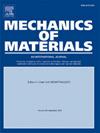Impact of position and density of nanoscale voids on fracture initiation in iron from phase field fracture simulation
IF 3.4
3区 材料科学
Q2 MATERIALS SCIENCE, MULTIDISCIPLINARY
引用次数: 0
Abstract
Understanding the impact of helium bubbles on crack propagation is complex. A useful first study towards understanding bubble effects on fracture is to examine how voids impact fracture. In this work, we used phase-field fracture simulations to examine the influence of voids and their distribution on Mode I fracture in Fe. Assuming brittle fracture, two simulation configurations were considered: (1) nanoscale systems with one or two voids, and (2) nanoscale systems with an experimentally relevant distribution of voids, with up to 20 % void area. Results from simulations with one and two voids showed that voids within 10 nm of a crack tip reduce the stress required for crack growth, with the magnitude of reduction depending on void-to-crack orientation. Comparisons with linear elastic fracture mechanics and evaluation of one versus two void systems revealed deviations from linear superposition, implying complex interactions between void and crack tip stress fields. In multi-void simulations, as void sizes increase, the nearest void to the crack tip exerts a greater influence on fracture stress than the overall porosity. This study provides valuable insights into the relationship between void size and concentration, and the stress necessary for crack growth, marking a step forward towards understanding He bubble-induced fracture in ferrous materials.
基于相场断裂模拟的纳米孔洞位置和密度对铁中断裂起裂的影响
了解氦气泡对裂纹扩展的影响是复杂的。为了理解气泡对断裂的影响,一个有用的初步研究是研究空洞如何影响断裂。在这项工作中,我们使用相场断裂模拟来研究孔洞及其分布对铁中I型断裂的影响。假设脆性断裂,考虑两种模拟配置:(1)具有一个或两个空洞的纳米级系统,以及(2)具有与实验相关的空洞分布的纳米级系统,空洞面积高达20%。一个孔洞和两个孔洞的模拟结果表明,在裂纹尖端10 nm范围内的孔洞降低了裂纹扩展所需的应力,其减小幅度取决于孔洞到裂纹的方向。与线弹性断裂力学的比较以及对一个和两个空洞系统的评估揭示了线性叠加的偏差,这意味着空洞和裂纹尖端应力场之间存在复杂的相互作用。在多孔洞模拟中,随着孔洞尺寸的增大,离裂纹尖端最近的孔洞对断裂应力的影响大于整体孔隙率。该研究对空洞大小与浓度之间的关系以及裂纹扩展所需的应力提供了有价值的见解,标志着对铁材料中He气泡诱导断裂的理解向前迈进了一步。
本文章由计算机程序翻译,如有差异,请以英文原文为准。
求助全文
约1分钟内获得全文
求助全文
来源期刊

Mechanics of Materials
工程技术-材料科学:综合
CiteScore
7.60
自引率
5.10%
发文量
243
审稿时长
46 days
期刊介绍:
Mechanics of Materials is a forum for original scientific research on the flow, fracture, and general constitutive behavior of geophysical, geotechnical and technological materials, with balanced coverage of advanced technological and natural materials, with balanced coverage of theoretical, experimental, and field investigations. Of special concern are macroscopic predictions based on microscopic models, identification of microscopic structures from limited overall macroscopic data, experimental and field results that lead to fundamental understanding of the behavior of materials, and coordinated experimental and analytical investigations that culminate in theories with predictive quality.
 求助内容:
求助内容: 应助结果提醒方式:
应助结果提醒方式:


